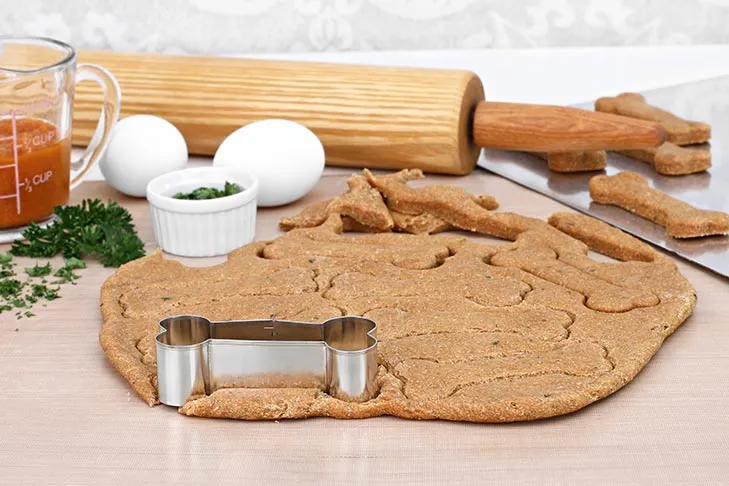Making homemade treats for your beloved canine companion offers numerous advantages over store-bought options. When you take the time to prepare these delightful bites, you gain complete control over the ingredients, ensuring your dog consumes only wholesome, beneficial foods free from unwanted additives, preservatives, or artificial flavors. This approach also allows you to cater to any specific dietary needs or allergies your dog might have, promoting better health and well-being. Plus, crafting treats at home can be a fun and rewarding experience for both you and your furry friend, creating a special bond as you provide them with something made with love. If you’re looking for simple yet nutritious ways to spoil your pup, these vet-approved homemade dog treats recipes are perfect. They are not only quick and easy to make but also packed with flavors your dog will adore. As a dedicated pet parent, you’re always seeking the best dog daycare or the finest foods, and these recipes perfectly align with that commitment to quality care.
Apple Pretzels for Pups: A Simple & Sweet Delight
These three-ingredient baked treats are surprisingly easy to whip up, even if the steps might seem extensive at first glance. If you’ve ever enjoyed making pretzels, you’ll find the process of rolling and twisting the dough to be quite enjoyable. Feel free to get creative with different shapes—your dog will be too busy savoring the delicious taste to mind how they look. This recipe offers a safe and enjoyable way to give your dog a special snack.
Ingredients
- 3 cups almond flour
- 1 egg
- 1 cup plain, unsweetened applesauce
Directions
- Preheat your oven to 350 degrees Fahrenheit (175°C).
- Line a baking sheet with parchment paper and set it aside.
- Beat the egg lightly in a small bowl and set aside.
- In a large mixing bowl, combine the applesauce and almond flour.
- Remove 1 tablespoon of the beaten egg and set it aside in a separate small bowl.
- Pour the remaining beaten egg into the large bowl with the applesauce and flour mixture.
- Stir the mixture thoroughly until a cohesive dough forms.
- Take a two-tablespoon-sized piece of dough and roll it into a tube shape.
- Form each tube into a “U” shape, then twist the ends together and fold them back towards the top to create a pretzel shape.
- Carefully place the shaped pretzels onto the prepared baking tray.
- Brush the top of each pretzel with the reserved tablespoon of egg.
- Bake for approximately 25-30 minutes, or until the pretzels are lightly browned and firm to the touch.
- Remove from the oven and allow them to cool completely before serving to your dog.
These apple pretzels are a fantastic way to introduce wholesome ingredients into your dog’s diet, offering a natural sweetness without added sugars. They’re also a great option if you’re mindful of your dog’s dietary needs and want to ensure they receive only the best.
 A happy Yorkshire Terrier sitting in the kitchen with its owner.
A happy Yorkshire Terrier sitting in the kitchen with its owner.
Blackberry Bliss Biscuits: Fruity & Flavorful Dog Treats
The next time you visit your local farmer’s market, consider picking up some extra fresh blackberries. These delicious berries are the star ingredient in these vet-approved blackberry biscuits, a treat your dog is sure to adore. The combination of natural sweetness and wholesome ingredients makes these biscuits an irresistible snack. You might even find yourself tempted to sneak a bite! These treats are particularly enjoyable after a long day of play, especially if your dog has spent time at a petco daycare or exploring outdoors.
Ingredients
- 4 cups almond flour
- ¾ cup flax meal
- ½ cup fresh blackberries
- 1 egg
- ¼ cup extra virgin olive oil
- 1 cup water
Directions
- Preheat your oven to 350 degrees Fahrenheit (175°C).
- Line a baking sheet with parchment paper.
- In a large bowl, mix all the ingredients—almond flour, flax meal, blackberries, egg, olive oil, and water—until a firm dough forms.
- Roll out the dough on a lightly floured surface until it is approximately 1/4-inch thick.
- Use a small cookie cutter to cut out various biscuit shapes.
- Gather any remaining dough, re-roll it, and cut out more biscuits until all the dough is used.
- Place the cut-out biscuits on the prepared baking sheet, ensuring they are about 1 inch apart.
- Bake for 30 minutes, or until the biscuits are nicely browned and feel firm.
- Remove the biscuits from the oven and allow them to cool completely before serving.
These wholesome biscuits provide a good source of fiber and antioxidants from the blackberries, making them not only tasty but also beneficial for your dog’s digestive health and overall vitality.
Mini Omelettes: A Protein-Packed Treat for Your Canine Companion
These mini omelettes offer a delightful and healthy treat that’s remarkably similar to what you might prepare for yourself, with one key difference: the absence of spices, herbs, and butter. Rest assured, your dog won’t miss those extras and will wholeheartedly enjoy this simple yet nutritious snack. They’ll be so engrossed in gobbling it down that you can easily make one for yourself without them minding! This is a fantastic option for a quick, protein-rich snack, especially when you need convenient dog minders near me for quick support.
Ingredients
- 2 eggs (Note: Raw egg whites can lead to biotin deficiency in dogs. Always ensure eggs are thoroughly cooked before offering them to your pet.)
- ½ cup cooked, thinly-sliced salmon or pulled grilled chicken (If using chicken, always ensure it is skinless and boneless.)
- ½ green bell pepper, diced
Directions
- Lightly grease a frying pan with a small drizzle of extra virgin olive oil.
- Place the frying pan on the stove and set the heat to medium-high.
- Crack the eggs into a bowl and whisk them with a fork until well mixed.
- Once the frying pan is heated, gently pour the mixed eggs into the center of the pan.
- Tilt the pan to spread the egg mixture evenly across the bottom.
- When the egg is halfway firm, sprinkle the diced green pepper and either the salmon or grilled chicken evenly over the surface.
- Using a spatula, carefully fold the omelette in half and continue to heat until the egg appears fully firm and cooked through.
- Remove the omelette from the pan and place it on a plate.
- Allow the mini omelette to cool completely before cutting into bite-sized pieces and serving.
 A Cavalier King Charles Spaniel resting its head on a kitchen table, looking expectant.
A Cavalier King Charles Spaniel resting its head on a kitchen table, looking expectant.
Cool & Chewy Frozen Meat Bites: Perfect for Hot Days
Chicken and carrots are consistently among dogs’ favorite foods, and this vet-approved frozen meat treat introduces another beloved ingredient: a touch of yogurt. These refreshing bites are ideal for warmer weather or as a satisfying chew. By freezing them in ice cube trays, you’ll have a convenient stash of ready-made treats available for your dog anytime they deserve a special reward. Ensuring your dog stays cool and hydrated is essential, much like finding doggy daycare near me prices that fit your budget when you need extra care.
Ingredients
- 2 cups grilled chicken (ensure the chicken is skinless and boneless)
- ¾ cup plain low-fat or fat-free yogurt (crucially, do not use yogurt containing xylitol, which is highly toxic to dogs)
- 1 carrot, finely shredded or diced (use a smaller amount if your dog has diabetes)
- 3 tablespoons extra virgin olive oil
Directions
- In a medium-sized bowl, stir all the ingredients—grilled chicken, yogurt, carrot, and olive oil—together until thoroughly combined.
- Carefully spoon the mixture into ice cube trays, filling each compartment.
- Place the filled ice cube trays in the freezer and allow them to freeze solid for several hours or overnight.
- For smaller dogs, you can alternatively pour the mixture into a piping bag and pipe small droplets onto a parchment-lined baking sheet before freezing, creating perfectly sized mini-treats.
- Once frozen, remove the treats from the trays and store them in an airtight container in the freezer.
These frozen meat bites are excellent for cooling down your dog, especially after energetic playtime or during hot summer afternoons, providing both hydration and a delicious snack.
Patriotic Pupsicles: Red, White, and Blue Yogurt Treats
Bursting with fresh berries, these vibrant red, white, and blue popsicles are more than just patriotic; they make a fantastic treat for your dog on the Fourth of July or any warm day when a refreshing snack is needed. As an added bonus, they are incredibly quick and simple to prepare, making them an accessible delight for any pet owner. Just remember to avoid xylitol in the yogurt, and adjust strawberry portions for diabetic dogs, just as you would carefully consider all aspects of golden retriever puppy care.
Ingredients
- 1 cup whole blueberries
- 1/2 cup chopped strawberries (use a smaller amount if your dog has diabetes)
- 1 cup plain yogurt (absolutely do not use yogurt containing xylitol, which is poisonous to dogs)
Directions
- In a bowl, gently mix all the ingredients—blueberries, strawberries, and plain yogurt—until just combined. Avoid overmixing to keep the distinct berry colors.
- Pour the mixture into an ice cube tray or a large silicone mold, filling each section.
- Place the tray or mold in the freezer and allow the mixture to freeze for at least 4-5 hours, or until completely solid.
- Once frozen, remove one popsicle from the mold and let your dog enjoy this frosty, fruity delight!
 Homemade dog treats baking supplies laid out on a table.
Homemade dog treats baking supplies laid out on a table.
Creating your own vet-approved homemade dog treats is a rewarding way to ensure your canine companion receives nutritious, delicious, and safe snacks. These recipes offer a variety of options, from baked pretzels and biscuits to savory omelettes and refreshing frozen treats, all designed with your dog’s health and happiness in mind. By controlling the ingredients, you can avoid common allergens and unhealthy additives, fostering a healthier lifestyle for your pet. Embrace the joy of making these treats and watch your dog delight in every wholesome bite. For more tips on pet health and care, continue exploring our comprehensive guides.
